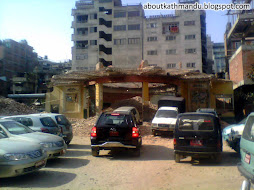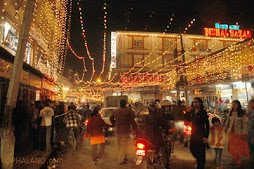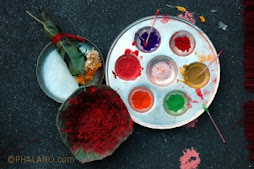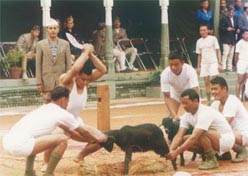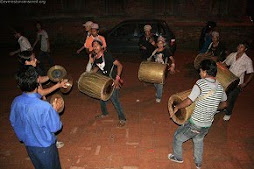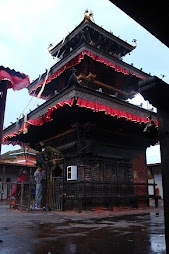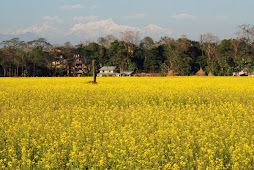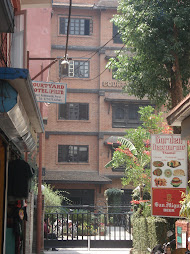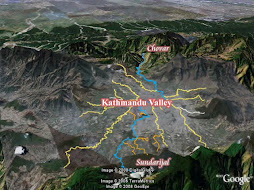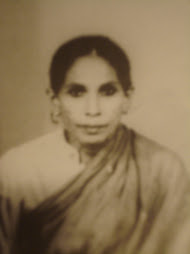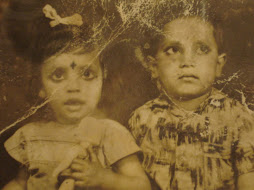I have been absent for a while – two international travels and several other things have kept me from resuming the blog.
Anyway, I want to continue the “river” theme. As I said in my previous postings, the rivers of Kathmandu have been the sources of my personal exposure to Kathmandu’s natural and cultural heritage. My grandmother, who passed away when I was almost 14 (the year was 1976), was cremated on the banks of Bagmati River at Raj Rajeswori Ghat (Ghat refers to the riverbank) As part of the Hindu rituals of mourning, my father and uncle (my father’s younger brother) spent 13 days at the Ghat. Since they had to stay away from others (we could not touch them, they could not touch us) as they were deemed to be in a state of impurity, my grandfather and I visited them daily from our house in Paknajole. The dam on the river right in front of the Raj Rajeswori Ghat made swimming on the river fun. The water was deep and relatively clean, to a fourteen year old boy, whose main delight in visiting my father and uncle was the opportunity to swim. It's not that I did not care about my grandmother's untimely death (she was in her early 60s), it was just something a fourteen year old could barely understand why the rituals were necessary.
I returned to the Ghat this year (May 2009; see photo - Raj Rajeswori Ghat is seen on the far left), and was saddened to notice what a difference 30 plus years of negligence had made to the river. The river was almost dry. Some Rhesus monkeys (Macaca mulatta) were frolicking around and taking dips in shallow pools of dirty water. The poor state of the monkeys was unpleasant to the eyes. They were certainly a health hazard to people. A body was being cremated at the Ghat. I looked away painfully, and glanced toward the Pashupatinath temple, as if to seek some comfort from the sights and sounds coming from the templeyard. People were worshipping, praying or just milling around. Some tourists were talking to their guide who looked as if he was trying to explain to his guests the daily life and death ritual of his countrymen. The midday glow reflected on the temple’s golden roof created a striking aura around the temple. Combined with people’s prayers, sadhus’ (yogi, or holy men) occasional cries of “Jai Sambho!” (Victory to Lord Sambho, or Pashupatinath), and constant ringing of cast-iron bells from all four directions, created an atmosphere which, I felt, was at once chaotic and peaceful. The harmony between chaos and peace was somewhat puzzling, as if it validated my belief that even in the dirtiest of dirt, one could find happiness and joy. The joy I had as a child swimming in the river, running barefoot amidst vegetable fields and fruit orchards, and wandering around with my friends looking for mischief and collecting cigarette boxes, all could have seemed chaotic, unsightly, and reckless to others. But, who cared? I was having all the fun and the world was in my pocket, so to speak.
My thoughts were interrupted, as I heard someone wailing and crying. I looked down on the river and saw that a group of men and women were following a funeral procession. Someone in the family had died and a funeral procession had arrived at the Ghat to cremate the dead person. Several men and women were leading the procession, and were scattering rice on the path of the dead body that was carried on the shoulders of four people (most likely sons and nephews, according to Hindu rituals). The whole affair made me very sad and reminded me of life's fragility, and that in a fleet of a moment it could come to an end. I stayed there for a little longer, and then left the scene quietly. A scene like this is played out every day on the banks of the Bagmati river, considered one of the holiest rivers in Kathmandu Valley. Bagmati, for the residents of Kathmandu, had thus become the cradle and grave, and in between, a source for nourishing life and livelihood, hopes and desires, dreams and imaginations. Growing up along its bank, its sinuous shape was embedded in my youthful mind as an imaginary path to be followed (wherever it lead), and its rising and falling tides the vicissitudes of my childhood journey. A journey, which would take a three-year old boy to Khajuri, a small village near the Indo-Nepal border 20 plus kilometers from the town of Janakpur in Southern Nepal.
More about the journey in my next blog…
Thursday, July 30, 2009
Subscribe to:
Posts (Atom)
